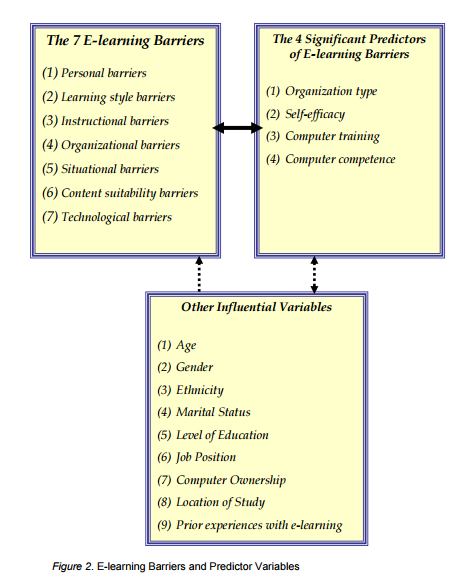Is E-learning Implementation in Your Organization Smooth?

The World Wide Web and latest technological innovations have influenced how learning and training takes place in organizations. Elearning is one learning format that has given learners control of how and when they choose to learn. It also helps organizations reach out to a geographically dispersed workforce at the time of need. Most importantly, it has the potential to cater to the ever-growing and changing demands of businesses at lowered training costs.
→ Download Now: State of Learning (Now and Beyond) [eBook]
With all its benefits, you would assume elearning implementation is a breeze. But it is generally not so. As a matter of fact, the greatest resistance to elearning comes from within the organization.
Mungania in his paper, “The Seven Elearning Barriers Facing Employees”, beautifully illustrates the complex web of barriers that organizations are likely to face during elearning implementation.

Note: The bold arrows indicate direct influence, while the dotted arrows indicate indirect influence (Mungania, 2003).
The barriers vary depending on the organization type, self-efficacy and comfort level of individuals in operating computers. For example, an employee of a technological company is less likely to oppose elearning as against an individual in an oil and gas organization. Similarly, as individual who is at ease operating a computer is less likely to protest against elearning as opposed to someone with limited computer knowledge. You will need to understand and estimate the barriers to elearning implementation, keeping in mind organizational and employee profiles, along with their related variables.
By and large, we see that employees are reluctant to embrace elearning willingly for the following reasons.
Personal Barriers:
Employees who are used to traditional classroom training rely on the information provided by an instructor who is physically present throughout the training program. In a way, they surrender ownership to the instructor and are lost when they need to steer their own learning. They do not know how to motivate or discipline themselves to direct their own learning that is required for elearning. Lack of self-motivation and self-discipline, perhaps the two important components of eLearning, are the biggest barriers to elearning implementation.
Learning Style Barriers:
Employees may be unwilling to move to another form of learning. They are used to a particular format and may just want to stick to it. They don’t see any reason to change and do not appreciate the management’s efforts to bring in a new method of instruction. Added to this, if employees are not motivated to improve their knowledge and skills as they do not understand the positive effect on their careers, resistance is imminent.
Instructional Barriers:
Elearning curriculum has to be different from classroom curriculum. It needs to be designed to engage an individual who is working alone. It has to be aligned accurately with the learning objectives. Therefore, it has to be designed keeping in mind the limitations and distractions that surround an elearning. If the content is not structured well, the course content is not inspiring or relevant to the job of the learner, it is bound to act as a barrier to successful elearning adoption. The elearning will have no takers.

A Bird’s Eye View of What Top-Performing L&D Teams are Doin
- Aligning Learning Strategy with Business Strategy
- Developing Business Skills for the Future
- Investing in the Right Technology
- Much More
Situational Barriers:
Depending on the structure and hierarchy of the training department, there may be resistance from the L&D staff, Training Managers, or Subject Matter Experts(SMEs) towards elearning. They may feel their role and importance in the organization will be diminished or made redundant. They may also be unwilling to change their way of work as training for an online medium merits changes in instructional design and curriculum development. They may also have to work closely with the technology team or multimedia developers and might feel their role is limited and undermined.
Content Barriers:
Elearning is like a new product launch. Just as with any new launch, you need to get customer buy-in (in this case, the employees and other stakeholders). If they are not informed of why the organization has decided to make this change, they will not lend their support. Ideally, there should be elearning champions who will bat for elearning and spread the good word around the organization. A proper communication plan has to be in place prior to elearning implementation. If it isn’t, elearning implementation might face a bumpy ride.
Organizational Barriers:
The budget required to successfully implement eLearning in place of traditional classroom training can sometimes be seen as a barrier. However, if the ongoing costs of classroom training are realistically assessed, it will be clearly seen that eLearning is much more cost-effective. But as it is seen as a huge investment, decision-makers are usually hesitant to make the move.
Technological Barriers:
Internet bandwidth, browser compatibility, ease and use of the Learning Management System (LMS) are some of the technological barriers that create hitches during elearning implementation. Ideally, it is essential that you estimate the Internet speed, browser versions, and devices that are likely to be used for accessing elearning before even developing elearning courses. These factors have to be kept in mind while choosing the interactivities and user interface for the elearning courses.
It is not necessary that all organizations face all these barriers, but as suggested by Mungania, you could take a look at the predictors and weigh them against the position your organization is in and estimate where you are likely to hit a road block. You can take preventive measures accordinlgy.





![Insider’s Guide for L&D Pros to Building a High-Performing Hybrid Employee Learning Strategy [eBook]](https://blog.commlabindia.com/hubfs/Imported_Blog_Media/LD-professionals-Heres-a-Guide-to-Build-High-Performing-Hybrid-Employee-Learning-Strategy-eBook-min-1.png)